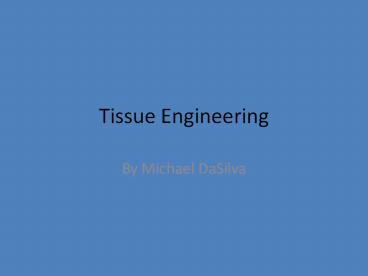Tissue Engineering - PowerPoint PPT Presentation
Title:
Tissue Engineering
Description:
Tissue Engineering By Michael DaSilva Tissue Engineering Tissue engineering is the field of biomedical engineering that s goal is to create new cells that helps ... – PowerPoint PPT presentation
Number of Views:94
Avg rating:3.0/5.0
Title: Tissue Engineering
1
Tissue Engineering
- By Michael DaSilva
2
Tissue Engineering
- Tissue engineering is the field of biomedical
engineering thats goal is to create new cells
that helps heal organs and if need be, to create
an entirely new organ. - The main point of tissue engineering is to make
it easier basically reproduce organs in order to
make peoples lives better.
3
How it works
- There are three basic steps in tissue
engineering. - The first step is actually getting the base cells
to work with. - The second step is putting the altered cells into
a scaffold in order to incubate the cells. - The final step is to put the newly created cells
or organ into use.
4
Step 1- Creating the Materials
- The materials that are used for tissue
engineering are actually living cells that were
taken from somewhere else. - These cells are then modified to whatever kind of
cell is needed. - There are 7 sources from where you can get these
cells.
5
7 Sources of Cells
- Autologous- Come from the person that needs the
new cells. - Allogenic- Come from a body from the same
species. - Xenogenic- Come from a different species then the
organism theyre going into. - Syngenic- Come from genetically identical epople.
(Twins) - Primary- Come from any organism.
- Secondary- Come from a cell bank.
- Stem cells- Undifferentiated cells.
6
Step 2-Bioreactors and Scaffolds
- Bioreactors are used in an attempt to recreate
realistic physiological environments so that the
cells can grow in a natural manner. - Once the cells are obtained, they are then put
into a scaffold to let the cells grow into their
new forms. - The original problem with creating new organs was
that they would die before they could get placed
into the organism that needed them. - This problem has been solved with the recent
developments in 3D printers, which allows for
blood vessels to be put into the new organ.
7
8 Types of Scaffolds
- Nanofiber Self-Assembly
- Textiles
- Solvent Casting Particulate Leaching
- Gas Foaming
- Emulsification/Freeze-drying
- Thermally Induced Phase Separation
- Electrospinning
- CAD/CAM
8
Step 3- Usage
- This step obviously is when the newly created
cells are put into use. - Whether they are being used to create a new organ
via the 3D Organ Printer, or they are being used
as new skin.
9
Future
- I see tissue engineering as a very promising
field in Biomedical engineering. - It can solve many of the problems that people
experience today. - It will eventually continue to grow and become
and make the need for a donor list obsolete as
they will be able to just grow organs
specifically for people.































